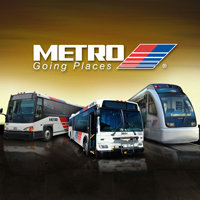I like the idea. It will need some careful thought and planning, but the idea seems to be on the right track to me.
The Metropolitan Transit Authority spent decades developing a network of parking lots where drivers could leave their cars and trucks and take transit to work. Now, its leaders are wondering whether those parking lots would be a attractive places for developers who may view those commuters as potential customers.
Metro officials are soliciting proposals for transit-oriented design, in which developers can submit proposals to synch transit center and bus depots with new apartments and shops.
“This is about bringing quality of life to areas adjacent to transit centers, to park and rides,” Metro Chairman Sanjay Ramabhadran said.
Metro’s interest extends to both properties it owns and those it leases from private developers. A number of park and ride lots are conventional bus shelters, with parking available in a commercial lot normally used by a grocery or department store that does not have high volumes during the work day.
The agency is starting slowly, after making some headway with a 2015 study to assess potential uses around park and ride locations. The board in August created a subcommittee tasked with joint development and land use, which met for the first time Sept. 14. Staff, meanwhile, issued a request for information to developers, the first step in seeing if any have ideas for using Metro spaces.
“I like the approach that we are asking the market to come to us,” said Diann Lewter, the Metro board member appointed to chair the new committee.
Though possibilities are just now beginning to take shape – a first round of proposals are due at the end of the month, followed by months of analysis and public meetings – some board members said they were eager to move ahead.
“I am really anxious to see it work as fast as possible,” Lewter said.
[…]
Metro already is sitting on very desirable land in the medical center. Located across Fannin from MD Anderson Cancer Center and across Pressler from UT Health’s health science center, the transit center has drawn interest for major projects, all willing to maintain its bus access.
When approached in 2018 with an unsolicited offer that later drew a competing proposal, however, Metro opted to keep things as they were because neither project, officials concluded, would improve transit access for existing riders. Instead, both projects had the potential to encourage hundreds of daily vehicle trips into the crowded medical center.
“Although both proposals provided estimated revenue streams and various amenities, the potential issues related to the customer experience was the overriding factor in … the decision to not move forward with this solicitation” Metro staff wrote in a summary to cancel the discussions.
As land becomes more scarce in key locations, though, Metro at the very least may have to rethink its current use of wide-open, flat parking lots.
“If you build structured parking, you free up a lot of land that can be used for workforce housing, said Barry Goodman, a former Metro president who now consults with Houston-area governments on transportation matters through his company, The Goodman Corporation.
It’s a long story, so read the rest. Not everyone on the Metro board thinks this is a great idea, there are some comparisons to other transit agencies that go both ways, and there’s the unfortunate return of a longtime anti-transit troll who’s back to spew some baloney. As I said, I like the general idea and think it’s worth a long look, but it’s fine if we take things slowly and conservatively.

